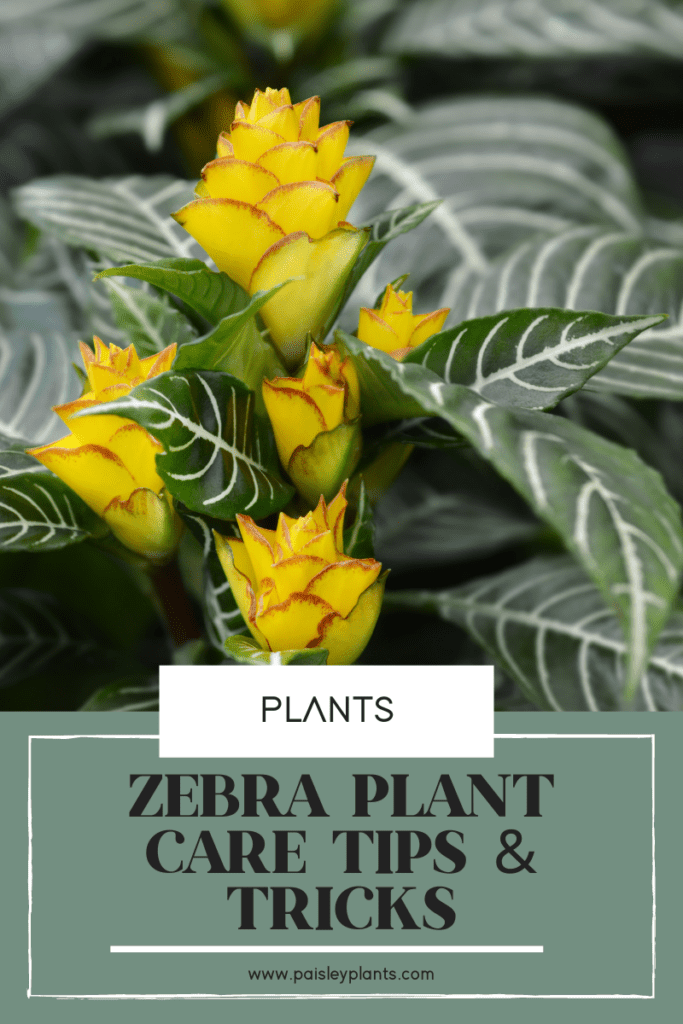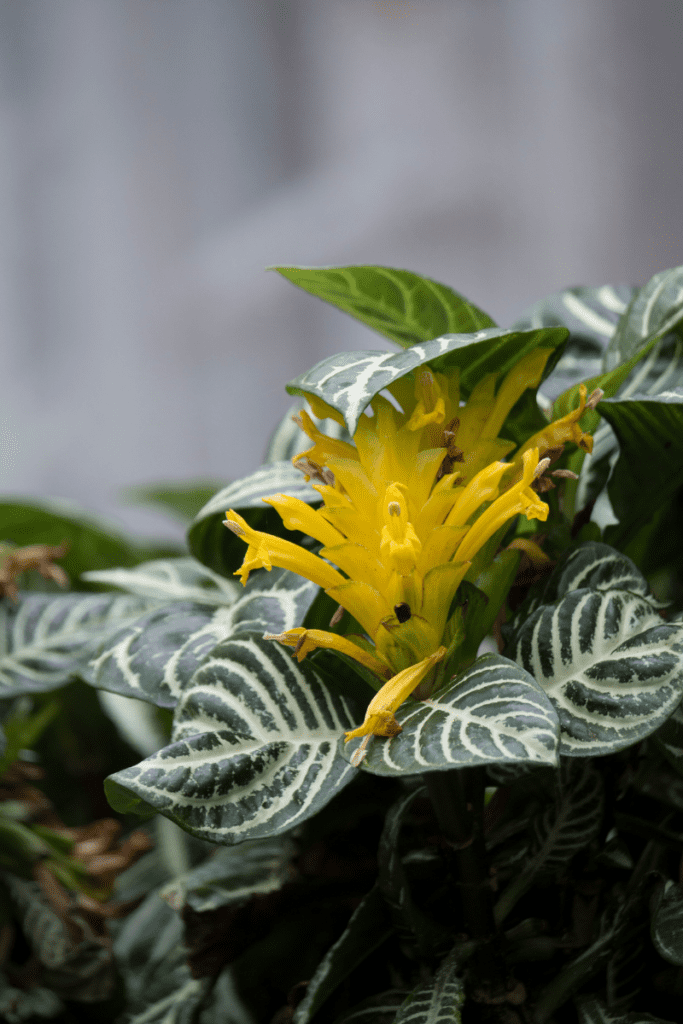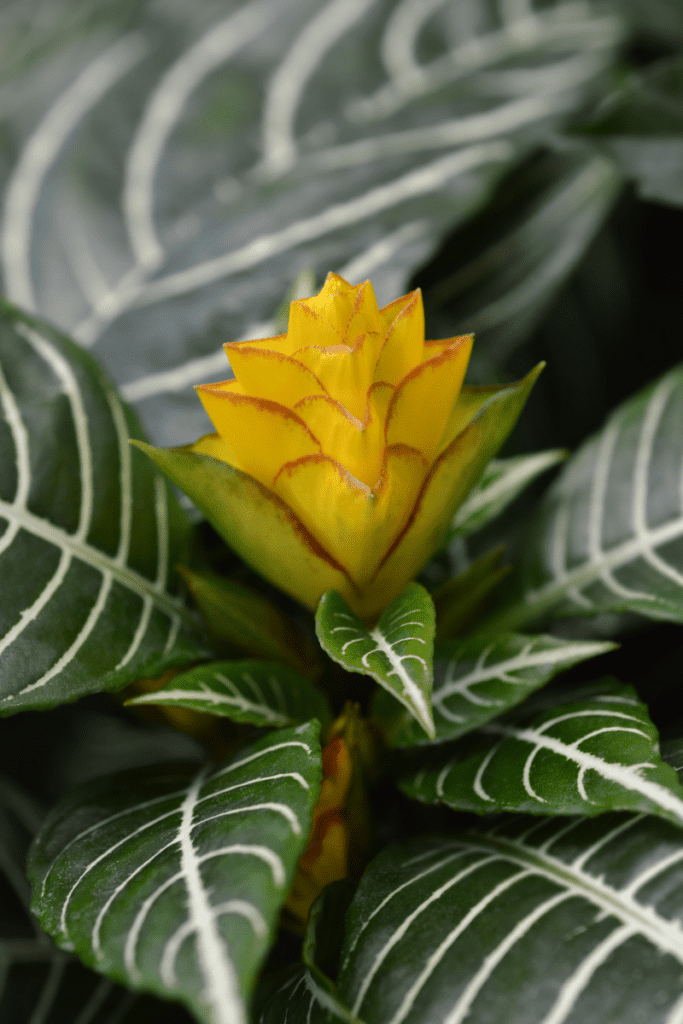Beautiful? Absolutely. Exotic? You bet. Difficult? Only a little! Enter: the zebra plant.
This beautiful striped flowering plant has been a favorite in households for years. While the zebra plant is a somewhat tricky plant to care for, don’t let this turn you off.
With this ultimate care guide, you too can grow a perfect zebra plant!

This post includes affiliate links.
Table of Contents
Background
Native to the rainforests of Brazil, the Aphelandra squarrosa (common name is zebra plant), has globalized into the homes of gardeners worldwide. While it can be somewhat challenging to care for a zebra plant, its striking beauty makes it worth the work!
Zebra plants are identifiable by their dark green leaves that are adorned with bright white veins and stripes. During the late summer and early fall, the zebra plant produces 2 to 4 tall bright yellow flowers.
These flower spikes can grow a few inches in height. The zebra plant at full maturity can reach a height of 1 to 2 feet tall when grown indoors. In its natural habitat, a wild zebra plant can grow to 4 to 6 feet tall.
While the zebra plant is considered non-toxic, the sap that this plant releases can cause skin irritation. Therefore, it is recommended to wear gloves when pruning your plant.
In addition, the flowers produced by the zebra plant may produce spikes that could cause harm. It’s a good idea to keep these out of reach of pets or small children.
*Head here for non-toxic plants!
To make matters confusing, there are actually three different plants that are called “zebra plants”. There’s the Aphelandra squarrosa that we’re going to discuss today. There’s also the calathea zebrina from the Calathea family. And there’s also a succulent, Haworthiopsis fasciata which also goes by zebra plant!
Zebra Plant Care Tips

Let’s learn all the proper care tips and tricks for your zebra plant.
Sun & Light
In their natural habitat, the zebra plant is used to growing under the shade of the rainforest canopy where it doesn’t get much bright light. In your household, you should place your zebra plant in a location that receives partial or bright indirect light.
Do not expose your plant to direct sunlight, as this could cause the leaves to burn. At the same time, your plant should not be placed in total shade; a complete lack of light will prevent your zebra plant from blooming.
Water
Zebra plants enjoy a soil that is consistently moist. However, at the same time, overwatering has a negative impact on your plant’s leaves and can cause wilting. Give your zebra plant a deep, thorough watering with lukewarm water.
Water your plant until you see water coming out from the drainage holes; this will ensure every layer of soil has been watered. When your soil has begun to start drying, you may re-water your plant. You may likely need to water your zebra plant less during winter months as these plants enter semi-dormancy.
Soil

The zebra plant is tolerant of many types of soil. An all-purpose potting mix from the plant nursery will work well with this plant.
Many gardeners opt to include coarse sand or perlite to their potting soil to increase the drainage. The ideal pH range for your zebra plant is a soil that is neutral to acidic.
Fertilizer
Adding a fertilizer routine to your zebra plant care will help encourage strong growth and promote flower blooms. During its growth season (spring and summer), feed your zebra plant a fertilizer that is tailored to promoting foliage and flower growth.
This fertilizer should be applied every one or two weeks only during the growing season.
Temperature & Humidity
As a tropical plant, the zebra plant enjoys moderately warm temperatures. The house temperature should be at least 60° F. Never allow your zebra plant to dip below 55° F, therefore avoid placing your zebra plant near drafty windows or air conditioning vents. Try to avoid fluctuations in home temperature or cold drafts, instead try to maintain an even temperature.
Zebra plants also enjoy high humidity levels. The household humidity level should be between 60 to 70% humidity. If your home tends to be on the dry side, adding an air humidifier to your home is an excellent way to achieve an acceptable level of humidity.
Choosing a Container & Repotting
Zebra plants require a pot with drainage holes. Drainage holes are important to keeping your plant’s soil properly moist without trapping water. Trapped water can heighten your plant’s risk of bacterial and fungal diseases, most notably root rot.

Zebra plants grow at a moderate pace and do not have to be repotted every year; in fact, they enjoy being a bit root bound. If you do feel like your plant is ready for a new pot, size up as gradually as possible.
Select a plant pot that is about 1 to 2 inches larger than the previous. When repotting, try to shake off as much old soil as possible and replant using fresh potting mix.
How to Prune a Zebra Plant
Always begin pruning your zebra plant using sterile, sharp scissors. Dip your shears in either rubbing alcohol or a 1:10 bleach-to-water solution. Taking this extra step will reduce the risk of bacterial infection and save you from heartbreak in the future.
Make sure to monitor the flower bract on your zebra plant. When the flower starts to wilt, you should remove it as soon as possible. If you wait too long, the lower leaves may begin to droop.
In addition, it is always recommended to trim any dead or damaged foliage; doing so will redirect your plant’s energy to develop bushier growth.
How to Propagate
Zebra plants can be easily propagated via stem cuttings from the mother plant. Follow these steps to make your zebra plant multiply! For best results, propagate your zebra plant in late spring or summer months.
- Take a healthy cutting from your zebra plant. This cutting should be at least 2 to 3 inches long and come from the side shoots of the zebra plant.
- Dip the cut end in rooting hormone powder; this will increase the rate of rooting in your cuttings.
- Fill a container with moist soil and insert the cut-end of the stem into the soil.
- If your home temperature cannot sustain at least 70° F, then place your container on a heating pad.
- Your cutting will also need a lot of humidity in order to successfully root. You can increase humidity by placing a plastic bag over the top of your pot.
- It takes roughly four weeks for the stem cutting to begin rooting. Be on the lookout for new growth forming. If you’re unsure your plant has rooted, try giving it a gentle tug. If you’re met with any resistance, then that is a good indicator that your plant has rooted.
- When roots have formed and your plant has established, you should repot your zebra plant into a regular plant pot.
*Check out some of my favorite propagation stations here!
Pests
Whiteflies
Whiteflies are a pest that you might encounter with the zebra plant. These are tiny, flying insects that suck out the nutrients from your plant, causing the leaves to develop yellow dots.
To fight whiteflies, you can lay out yellow sticky tape to catch flies. In addition, treating your plant with an insecticidal soap is also helpful in controlling the infestation. Any foliage that has been affected by whiteflies should be pruned and disposed of.
Mealybugs
These small insects also suck out nutrients from your plant’s foliage and often leave a sticky, cottony residue on the plant’s foliage. You can help control these pests by wiping your plant with a cotton swap dipped in rubbing alcohol.
Spraying your plant with neem oil is also effective in preventing mealybugs from returning.
Zebra plants are also susceptible to spider mites.
Diseases
Botrytis Blight
Botrytis is a type of mold that is commonly found on the edges of your zebra plant’s leaves. If left untreated, it can spread to all of your leaves and cause collapse.
Early detection is key to stopping the spread of botrytis. If you notice an outbreak, prune all leaves that have been afflicted and completely dispose of the leaves.
Pythium Root Rot
Root rot is a fungal condition that is the result of overly-wet conditions from too much water. Overwatering your zebra plant, combined with inadequate drainage is a recipe for root rot.
In certain cases, root rot can be treated by pruning the dead roots and repotting in fresh soil. However, the key to tackling root rot is prevention. Always make sure your soil is moist, but not waterlogged. Wait until your soil is just beginning to dry before rehydrating the soil.
Common Problems
My leaves have yellow spots all over them!
This leaf spots sounds like a pest infestation. Pests such as mealybugs or whiteflies suck the sap right out from your plant. Inspect your plant to check for any small insects.
Prune any signs of leaf damage on your plant. Treating your plant with either an insecticidal soap or neem oil are your best lines of defense against pests.
My plant is wilting and turning yellow!
Wilting, yellowing plant foliage are all signs of root rot. If your soil is soaked with water, and you’re experiencing these symptoms, remove your plant from its pot and inspect the roots.
Rotted roots are dark and mushy in texture. Use a sterilized pair of shears to trim these rotted roots and repot using clean, new soil.
My plant has brown leaf tips!
This is a sign of overexposure to much light and over-fertilization. Keep in mind that the zebra plant enjoys bright, indirect light. Do not expose them to too much sunlight and direct rays.
In addition, try to cut back on fertilization. If you’re fertilizing your plant on a weekly basis, try cutting it down to once every two or three weeks.
Where to Buy a Zebra Plant
Closing
Don’t let its lofty care requirements steer you away- the zebra plant will be a beloved member of your plant family! With its vibrant flowers and striped leaves, the zebra plant will turn the heads of every houseguest you have.
If you want more flowering plants, check out the spotted begonia or Hoya Obovata!

